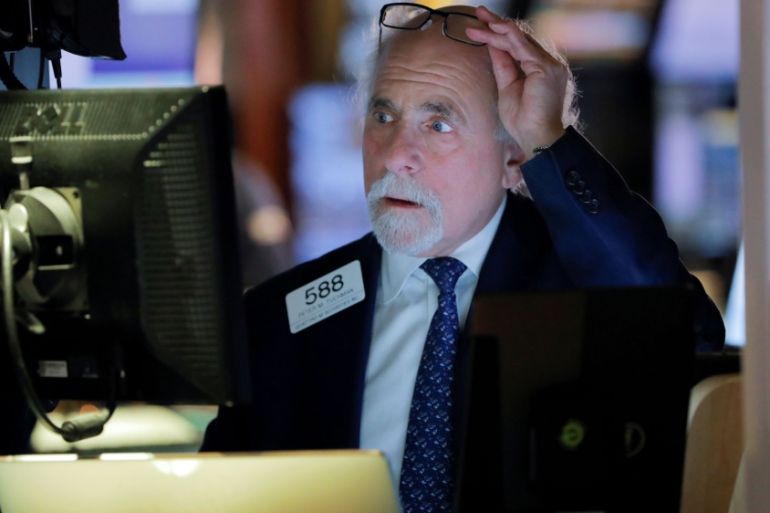Brutal: US stocks hammered again despite Fed’s emergency rate cut
Fed’s surprise move sparked a brief rally, only to see investors succumb again to fears over coronavirus impact.

The Federal Reserve donned its metaphorical cape on Tuesday and swooped down on nervous markets with an emergency interest rate cut the likes of which have not been seen since the height of the global financial crisis in 2008.
But not even that grand gesture could stem the sinking feeling among investors that coronavirus could take one heck of a toll on the US and global economies.
Keep reading
list of 3 itemsCurbing US travel unlikely to curb coronavirus spread say experts
G7 pledges to mediate coronavirus fallout as US fed slashes rates
Right after news hit that Fed policymakers had slashed the federal funds rate by half a percentage point, the Dow Jones Industrial Average vaulted 350 points higher. But the index soon turned tail and headed lower again.
After bouncing around, moving in and out of negative territory, that sinking feeling finally won out to see the Dow close down 785.91 points or almost 3 percent – the eighth negative finish in nine trading days.
The broader S&P 500 Index- a proxy for United States retirement accounts – gave back 2.8 percent while the Nasdaq Composite Index fell 3 percent.
“The market realizes rate cuts are not the appropriate policy response to growing deflationary pressures,” Steven Ricchiuto at Mizuho securities wrote in a note to clients.
While the stock market could not keep the darkness out, US treasuries drew investors like moths to a flame.
The yield on the 10 year US treasury – used as a benchmark for US mortgages and student loans – sank below 1 percent for the first time. Ever.
Gold, a perennial safe haven during times of mounting uncertainty, gained nearly 3 percent.
When grand gestures are not enough
Not only did the Fed come through with a rate cut between scheduled meetings, something it has not done since 2008, it also produced the biggest one-off cut since the global financial crisis.
During a news conference following the rate cut, Federal Reserve Chairman Jerome Powell told reporters that the coronavirus outbreak and measures being taken to contain it “will surely weigh on economic activity both here and abroad for some time”, adding that “the magnitude and persistence of the overall effects on the economy, however, remain highly uncertain and the situation remains a fluid one.”
The half a percentage point cut lowers the federal funds target range to 1 percent- 1.25 percent. Fed policymakers voted unanimously to back the move and signalled in a post-meeting statement a willingness to cut rates even further if necessary.
Policymakers are scheduled to meet on March 16-17.
“We now expect the Fed to follow that reduction with an additional 25bp [a quarter of a percentage point] rate cut at the FOMC meeting scheduled for the middle of this month,” said Paul Ashworth, chief US economist at Capital Economics.
“Nevertheless, our forecast is based on the assumption that the number of domestic cases remains relatively limited – rising to the tens of thousands rather than millions. In the event of a more severe outbreak, the US could experience a mild recession, prompting the Fed to cut rates to near-zero again and Congress to deliver a fiscal stimulus via some form of rebates or a payroll tax cut,” Ashworth noted.
On Tuesday, Australia‘s central bank took the lead among developed economies after the country’s central bank cut its benchmark rate to a record low, citing challenges to growth from coronavirus.
US President Donald Trump seized upon Australia’s rate cut to prod the Fed to follow suit, tweeting that the Fed “Should ease and cut rate big. Jerome Powell led Federal Reserve has called it wrong from day one. Sad!”.
When asked by reporters on Tuesday whether political pressure had influenced the Fed’s interest rate policy, Powell said: “We’re never going to consider any political considerations whatsoever.”
On Monday, the Organisation for Economic Cooperation and Development (OECD) warned coronavirus “presents the global economy with its greatest danger since the financial crisis.” It lowered its forecast for global growth to 2.4 percent for the whole year but cautioned that “broader contagion across the wider Asia-Pacific region and advanced economies” could bring global growth to as low as 1.5 percent this year – half of what it had forecast in November.
On Tuesday, the World Bank announced an initial package of up to $12bn in immediate funds to help countries with crisis financing to lessen the impact of the coronavirus outbreak.
“The point is to move fast; speed is needed to save lives,” World Bank President David Malpass said during a teleconference with reporters.